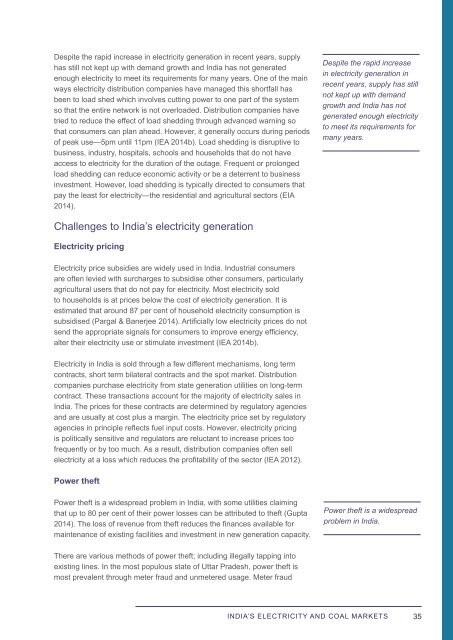Coal in India
1P05mmm
1P05mmm
Create successful ePaper yourself
Turn your PDF publications into a flip-book with our unique Google optimized e-Paper software.
Despite the rapid <strong>in</strong>crease <strong>in</strong> electricity generation <strong>in</strong> recent years, supplyhas still not kept up with demand growth and <strong>India</strong> has not generatedenough electricity to meet its requirements for many years. One of the ma<strong>in</strong>ways electricity distribution companies have managed this shortfall hasbeen to load shed which <strong>in</strong>volves cutt<strong>in</strong>g power to one part of the systemso that the entire network is not overloaded. Distribution companies havetried to reduce the effect of load shedd<strong>in</strong>g through advanced warn<strong>in</strong>g sothat consumers can plan ahead. However, it generally occurs dur<strong>in</strong>g periodsof peak use—5pm until 11pm (IEA 2014b). Load shedd<strong>in</strong>g is disruptive tobus<strong>in</strong>ess, <strong>in</strong>dustry, hospitals, schools and households that do not haveaccess to electricity for the duration of the outage. Frequent or prolongedload shedd<strong>in</strong>g can reduce economic activity or be a deterrent to bus<strong>in</strong>ess<strong>in</strong>vestment. However, load shedd<strong>in</strong>g is typically directed to consumers thatpay the least for electricity—the residential and agricultural sectors (EIA2014).Despite the rapid <strong>in</strong>crease<strong>in</strong> electricity generation <strong>in</strong>recent years, supply has stillnot kept up with demandgrowth and <strong>India</strong> has notgenerated enough electricityto meet its requirements formany years.Challenges to <strong>India</strong>’s electricity generationElectricity pric<strong>in</strong>gElectricity price subsidies are widely used <strong>in</strong> <strong>India</strong>. Industrial consumersare often levied with surcharges to subsidise other consumers, particularlyagricultural users that do not pay for electricity. Most electricity soldto households is at prices below the cost of electricity generation. It isestimated that around 87 per cent of household electricity consumption issubsidised (Pargal & Banerjee 2014). Artificially low electricity prices do notsend the appropriate signals for consumers to improve energy efficiency,alter their electricity use or stimulate <strong>in</strong>vestment (IEA 2014b).Electricity <strong>in</strong> <strong>India</strong> is sold through a few different mechanisms, long termcontracts, short term bilateral contracts and the spot market. Distributioncompanies purchase electricity from state generation utilities on long-termcontract. These transactions account for the majority of electricity sales <strong>in</strong><strong>India</strong>. The prices for these contracts are determ<strong>in</strong>ed by regulatory agenciesand are usually at cost plus a marg<strong>in</strong>. The electricity price set by regulatoryagencies <strong>in</strong> pr<strong>in</strong>ciple reflects fuel <strong>in</strong>put costs. However, electricity pric<strong>in</strong>gis politically sensitive and regulators are reluctant to <strong>in</strong>crease prices toofrequently or by too much. As a result, distribution companies often sellelectricity at a loss which reduces the profitability of the sector (IEA 2012).Power theftPower theft is a widespread problem <strong>in</strong> <strong>India</strong>, with some utilities claim<strong>in</strong>gthat up to 80 per cent of their power losses can be attributed to theft (Gupta2014). The loss of revenue from theft reduces the f<strong>in</strong>ances available forma<strong>in</strong>tenance of exist<strong>in</strong>g facilities and <strong>in</strong>vestment <strong>in</strong> new generation capacity.Power theft is a widespreadproblem <strong>in</strong> <strong>India</strong>.There are various methods of power theft; <strong>in</strong>clud<strong>in</strong>g illegally tapp<strong>in</strong>g <strong>in</strong>toexist<strong>in</strong>g l<strong>in</strong>es. In the most populous state of Uttar Pradesh, power theft ismost prevalent through meter fraud and unmetered usage. Meter fraudINDIA’S ELECTRICITY AND COAL MARKETS35


